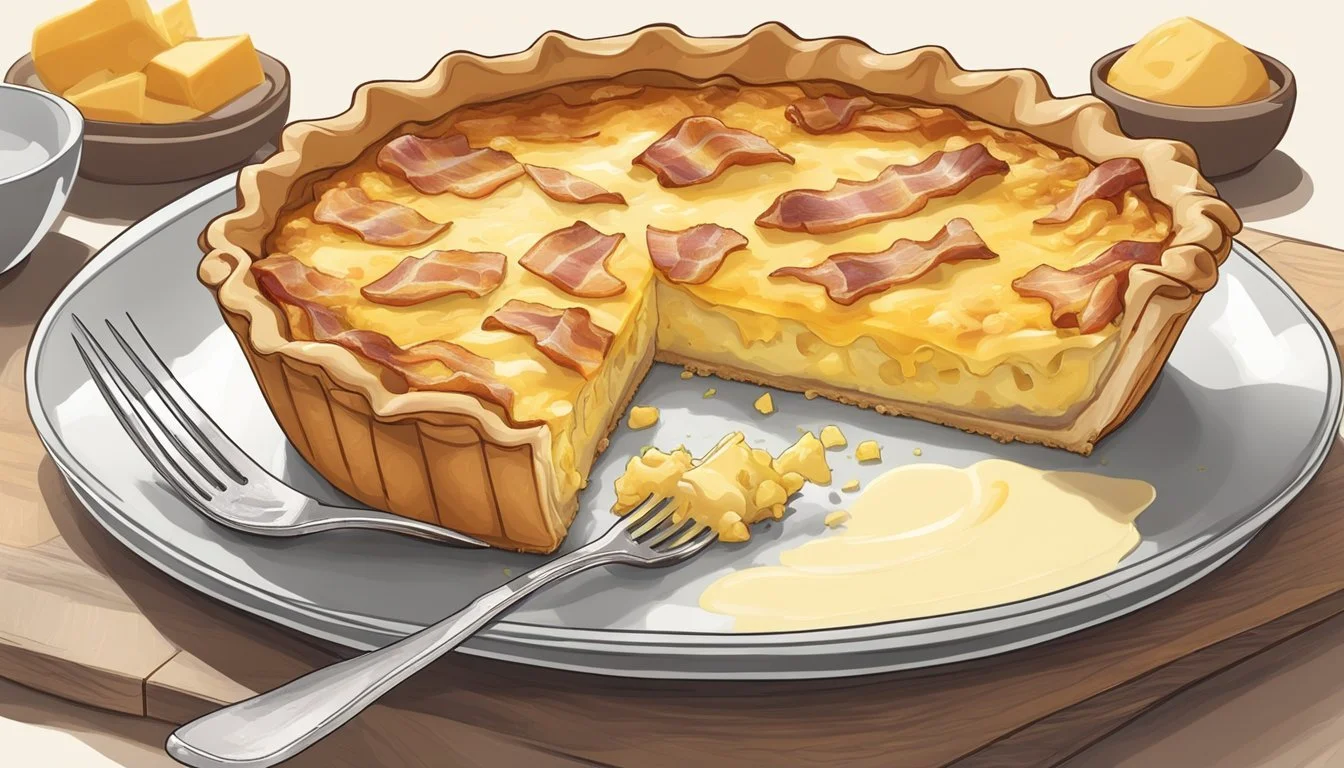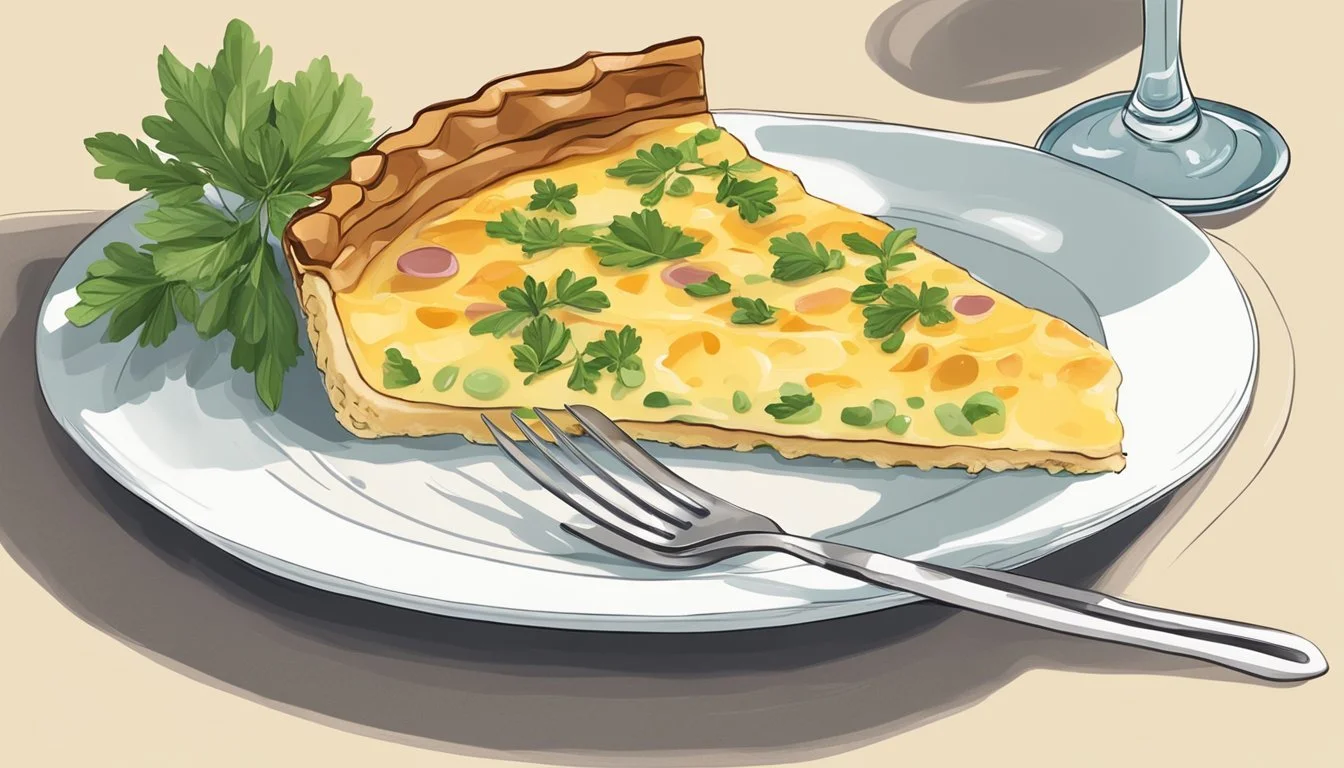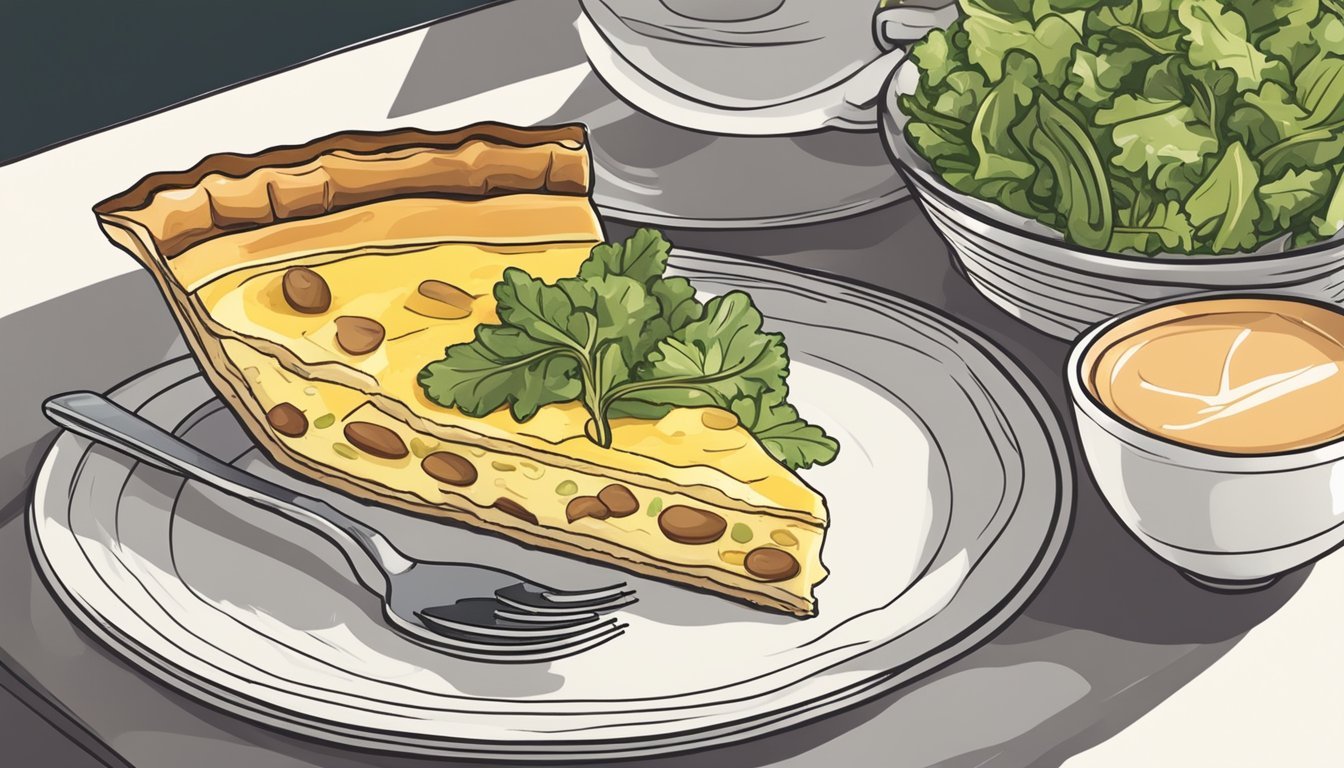How do you eat a quiche Lorraine?
Tips for Enjoying This Classic Dish
Quiche Lorraine is a classic French dish that marries a flaky pastry crust with a savory custard filling made of eggs, cream, cheese, and bacon (how long does bacon last?). It originates from the Lorraine region of France, hence its name. This dish is versatile and can be served for breakfast, brunch (What wine goes well with brunch?), lunch, or dinner. The richness of the custard pairs wonderfully with the smoked bacon and the subtle sharpness of Gruyère cheese, making Quiche Lorraine a beloved and timeless recipe.
When it comes to eating Quiche Lorraine, simplicity is key to experience its full array of flavors. It is typically served warm, although it's also delicious when eaten at room temperature, which allows the flavors to meld together beautifully. It can stand alone as a satisfying meal, but it may also be accompanied by a side of green salad dressed with a light vinaigrette to cut through the creaminess of the quiche.
Portioning Quiche Lorraine is straightforward; it is typically sliced into wedges, much like a pie. The quiche should be allowed to rest after baking so the custard sets properly and can be cut into clean slices. Properly reheating leftover quiche, if necessary, involves warming it in the oven to maintain the texture of the pastry and the richness of the filling. Whether freshly baked or reheated, Quiche Lorraine offers a delightful blend of texture and taste that is best appreciated when savored slowly.
Historical Context
Quiche Lorraine is a dish steeped in history, originating from the Lorraine region in northeastern France. This savory tart became a staple in the culinary world during the 16th century. It began as a modest meal for farmers, consisting of simple, available ingredients, reflecting the practicality and needs of its origins.
Initially, the traditional Quiche Lorraine was devoid of cheese, a distinction that differentiates it from its modern variations. The foundational elements were straightforward: a custard made from eggs and cream, with pieces of bacon or ham, all encased in a tender pastry shell. The quiche was principally a practical dish, satisfying and easy to prepare. Over time, as it was embraced by French cuisine, it evolved in both flavor and reputation.
By the mid-20th century, Quiche Lorraine reached greater popularity beyond its home region. As the dish spread internationally, the introduction of cheese became common, marking a divergence from the original recipe. Critics often highlight that such additions, while popular, move away from the dish's authentic roots.
Despite these adaptations, the essence of Quiche Lorraine persists, symbolizing the Lorraine region and its influence on not only French but global cuisine. The dish embodies the balance between sustenance and flavor that is characteristic of rustic French cooking.
Essential Ingredients:
Eggs
Cream
Bacon or ham
Common Additions: Cheese (in modern versions)
Overview of Quiche Lorraine
Quiche Lorraine is a savory pie, known for its simplicity and richness, which has captured the hearts of many who appreciate classic French cuisine. Originating from the Lorraine region of France, this dish is characterized by its buttery pastry crust filled with a delightful custard made from eggs and cream, punctuated with pieces of bacon and cheese.
Key Components:
Pastry Crust: Typically made from flour, butter, and water, creating a flaky texture.
Custard Filling: A smooth blend of eggs and heavy cream forms the base.
Bacon: Offers a smoky flavor, with most recipes calling for it to be cooked but not browned.
Cheese: Gruyère adds a nutty taste, although some variations may use Swiss or Parmesan.
Ideal Times to Serve:
Brunch: Its rich profile pairs excellently with lighter fare.
Lunch: Satisfying yet not overly heavy, ideal for a midday meal.
Dinner: May be accompanied by a salad to balance its decadence.
Often enhanced with a touch of seasoning — salt, pepper, and sometimes nutmeg or cayenne pepper — Quiche Lorraine can be served hot or cold. Whether in a classic deep pie pan or transformed into mini quiches for sharing, the dish remains a staple at gatherings. Despite its luxurious taste, the quiche Lorraine recipe is quite approachable for home cooks, emphasizing the importance of quality ingredients and proper technique.
Essential Ingredients
The success of a Quiche Lorraine hinges on the quality of its ingredients, which come together to create its rich flavor and delicate texture. Below are key components essential to preparing an authentic Quiche Lorraine.
Eggs and Dairy
Eggs are the base of the quiche filling, giving it structure and richness. Typically, four large eggs are beaten and combined with dairy to create a smooth custard. Dairy components include a balance of milk and heavy cream or crème fraîche, which contributes to the creaminess of the quiche. A common ratio for a lush texture is a half cup of each dairy component.
Meats
The meat of choice in a Quiche Lorraine is bacon, often required to be thick-cut and added in a generous quantity, around six ounces. The bacon is cooked until it's just crisp, ensuring it retains its texture and flavor after baking. Some variations may include ham as an alternative, but bacon remains the traditional choice.
Cheese Options
While Gruyère cheese is traditional in Quiche Lorraine, lending a nutty and slightly sweet flavor, alternatives like Swiss cheese or Emmental can be used. For a stronger taste, some might opt for cheddar. The cheese is usually shredded, with one cup being sufficient to achieve a good balance between the other ingredients.
Crust Considerations
A buttery pie crust forms the foundation of the quiche. It can be homemade or store-bought, but it should be pre-baked (blind-baked) to prevent sogginess. In terms of ingredients, a crust typically includes all-purpose flour, unsalted butter, and a pinch of salt; some recipes include a small amount of sugar for balance.
The crust is rolled out, fitted into a tart pan or deep pie pan, and then lightly frozen before the filling is added to help maintain its shape during baking.
Preparation Techniques
Proper preparation techniques are crucial for creating a sublime Quiche Lorraine, which involves meticulous custard making, crust crafting, accurate combining of ingredients, and precise baking.
Making the Custard
To make a savory egg custard, one starts by whisking together eggs and heavy cream with seasonings typically including salt, cayenne pepper, and a dash of nutmeg. The custard is the heart of the quiche and its consistency must be smooth for the best texture.
Crafting the Crust
A Quiche Lorraine requires a buttery crust, often made from a mixture of flour, unsalted butter, and a pinch of salt. One can choose to use lard for an even flakier texture. After combining these ingredients, the dough is rolled out, placed into a tart pan, and pressed down to mold to the shape. It's important to use a fork to lightly prick the bottom of the crust before baking. For best results, one might line the crust with parchment paper and use pie weights or dried beans to blind bake the crust, commonly at 350˚F, to avoid puffing and create a crisp base.
Combining Ingredients
After pre-baking the crust, one evenly spreads finely chopped shallots over the bottom, followed by half of the cooked bacon. They then sprinkle Gruyère cheese, and top with the remaining bacon. The prepared custard is poured over these layers to enable a harmonious blend of flavors upon baking.
Baking the Quiche
The Quiche Lorraine is baked until the custard is set and the top is slightly golden. Initially, par-baking or pre-baking the crust is essential to prevent sogginess; for example, the crust could be blind baked for about 40 minutes at 350˚F. Afterward, the filling is added, and the quiche might bake at a slightly higher temperature, such as 375 degrees, until completion. Baking times may vary, and one can check for doneness by inserting a knife into the quiche—it should come out clean.
Additional Variations
Quiche Lorraine, a classic French dish, offers a myriad of possibilities for customization. From savory meats and cheeses to a variety of vegetables and crust types, one can adapt the recipe to suit personal tastes or dietary requirements.
Savory Additions
For those seeking to enhance the rich flavors of Quiche Lorraine, additional proteins can be introduced. Smoked bacon can be substituted with or complemented by other meats such as ham or sausage. Incorporating shallots or caramelized onions adds depth, while a pinch of cayenne pepper provides a subtle heat. For a herby note, consider mixing in fresh herbs like thyme or chives.
Vegetable Inclusions
Vegetables can provide both nutritional value and a burst of color to Quiche Lorraine. Spinach and asparagus are popular choices, and both blend well with the creamy egg custard filling. For those who prefer a medley of vegetables, adding mushrooms, diced peppers, or tomatoes can create a more complex flavor profile. The inclusion of vegetables not only enriches the dish but also makes it a suitable option for a wider range of diets.
Alternative Crusts
The traditional pastry crust is a staple in any Quiche Lorraine, but alternative crusts can offer a unique twist or accommodate dietary restrictions. For a crustless quiche, simply omit the dough and pour the egg mixture directly into a greased pie dish. Those seeking a flakier texture may opt for puff pastry. For a lighter and gluten-free option, a crust made from potatoes or almond flour can serve as a delicious and health-conscious base.
Serving Suggestions
Quiche Lorraine, a versatile dish, can be enjoyed in an array of settings and pairings, here's how one can amplify the dining experience when indulging in this classic French tart.
For a Breakfast option, a simple yet elegant pairing would be a green salad. A light, crisp salad balances the richness of the quiche. It can be dressed with a red wine vinaigrette or a balsamic dressing, adding a nice zesty contrast to the creamy quiche.
One might consider these simple pairings:
Arugula Salad: Arugula leaves, a dash of olive oil, and sprinkles of salt.
Fruit Salad: A mix of seasonal fruits like apples, bananas, or berries for a sweet note.
For a hearty breakfast, here are further suggestions:
Hash Browns: Crispy and golden, made in an air fryer for convenience.
Bacon Strips: For added indulgence and to complement the bacon within the quiche itself.
In a table, the servings are as follows:
Breakfast Side Preparation Green Salad Light dressing, fresh greens Fruit Salad Seasonal fruits, hint of citrus Hash Browns Air-fried, seasoned, served crispy Bacon Strips Oven-baked or pan-fried until desired crispness
Whether one chooses to enjoy Quiche Lorraine warm or cold, these side dishes have been carefully selected to complement its flavors and textures for a truly satisfying meal.
Storage and Make-Ahead Tips
When it comes to storing Quiche Lorraine, refrigeration is key. The baked quiche should be allowed to cool to room temperature before being wrapped tightly in cling film or aluminum foil. It can be refrigerated for 3-4 days. For optimal freshness, it's recommended to place the wrapped quiche in an airtight container before refrigerating.
Freezing Quiche Lorraine:
Prep: Cool the quiche completely.
Wrap: Double wrap in cling film, followed by aluminum foil.
Label: Mark with the date; quiche can be frozen for up to 3 months.
Reheat: Thaw overnight in the fridge and reheat in a 350°F oven until just warmed through, typically for 20-25 minutes.
Make-Ahead Tips: Quiche is ideal for preparing in advance. Assemble the components separately:
Crust: A store-bought pie crust can save time. If pre-baking, allow the crust to cool, then wrap it to keep it fresh overnight.
Filling: Mix eggs, cream, and seasoning but do not pour into the crust until ready to bake.
Bacon and onions: Cook ahead of time and refrigerate.
Assembling: On the day of serving, combine the prepped ingredients, pour into the crust, and bake as directed. This approach minimizes soggy crusts and ensures a fresh, flavorful quiche.
Always remember to handle food with care, maintaining safe temperature controls to prevent spoilage and avoid potential foodborne illnesses.
Frequently Asked Questions
What is the best way to serve Quiche Lorraine?
Quiche Lorraine is typically served warm. One can gently reheat it in the oven if it has been refrigerated. It's recommended to let it stand for a few minutes after reheating to allow for easier slicing.
Can Quiche Lorraine be eaten cold?
Yes, it can be enjoyed cold, making it convenient for picnics or as a cold breakfast option.
Should Quiche Lorraine be reheated in a microwave?
It's preferable to reheat in an oven to maintain its texture. Microwaves can make the crust soggy.
Are there any specific pans that work best for Quiche Lorraine?
A tart pan with a removable bottom is ideal because it makes serving easier. However, a glass pie dish can also be used.
How does one remove the quiche from a removable bottom pan?
Cool the quiche slightly. Then, place the pan on top of a can, and gently slide the outer ring downward.
Is a glass pan a good alternative for baking Quiche Lorraine?
Glass heats up slowly but is excellent for even heat distribution. One must simply adjust the baking time accordingly, as it may take longer to bake the quiche evenly.
Complementary Pairings
When enjoying a quiche Lorraine, selecting the right side dishes enhances the dining experience. The ideal accompaniments should balance the rich and savory flavors of the quiche.
Salads:
Pear and Rocket Salad: A light choice, featuring the sweetness of pears and the peppery taste of arugula. Adding blue cheese and candied walnuts introduces complexity, while a balsamic vinaigrette ties it all together.
Arugula Salad: The freshness of arugula works well against the dense quiche. Tossing it with a simple dressing can brighten the palate.
Potatoes:
Air-Fryer Hash Browns: Potato hash browns provide a crispy contrast to the creamy texture of quiche. Cooking them in an air fryer ensures they are both healthy and delicious.
Soups:
Hearty varieties like split pea or vegetable soup create a comforting meal, pairing the warmth of the soup with the rich quiche.
Fruits:
A fruit salad offers a sweet and refreshing counterpoint. Use a mix of seasonal fruits to complement the flavors.
Beverage Pairing:
White Wine: A dry white wine is an excellent companion for quiche Lorraine. Its crispness cuts through the richness and cleanses the palate.
Sides should be selected to offer a variety of textures and flavors, ensuring each bite of quiche feels like a complete sensory experience. Whether one opts for the lightness of a salad, the warmth of a soup, or the crispness of hash browns, each side dish should contribute to a harmonic balance on the palate.
Cultural Significance
Quiche Lorraine holds a notable position within French culinary culture. Originally from the Lorraine region, the popularity of this savory tart expanded beyond its borders during the mid-20th century. Paris and other French cities soon embraced Quiche Lorraine, incorporating it into the tapestry of French cuisine renowned globally.
In France, food is closely tied to regional identity, and the Lorraine region has been influential in promoting its namesake dish. Quiche Lorraine embodies the authentic regional flavors with simple, local ingredients like eggs, cream, and bacon. It has become emblematic of French terroir, a concept which speaks to the regional specificity of food, potentially influenced by AOP (Appellation d'Origine Protégée) regulations that protect and celebrate traditional regional foods.
The dish's integration into culture surfaces in both high cuisine and home cooking, distinguishing it as versatile and approachable. The ease of creating a quiche allows it to transcend socioeconomic levels. Despite its humble beginnings, Quiche Lorraine is often associated with the sophistication of French culinary art, making frequent appearances at brunch spots and dinner parties alike.
As globalization increased the exchange of culinary traditions, Quiche Lorraine became a worldwide phenomenon, albeit occasionally adapted to suit local tastes. Its universality does not detract from its cultural significance in France, but rather underscores the impact French cuisine has had on international dining habits.
Tips for Perfecting the Dish
When seeking the quintessence of Classic French Quiche Lorraine, the key lies in mastering the texture of the quiche and judicious flavor enhancements.
Achieving Ideal Texture
For that perfectly silky and custard-like texture, it's crucial to balance your egg and dairy mixture. A Classic French Quiche Lorraine traditionally uses 4 eggs, combined with heavy cream. The ratio of eggs to cream significantly affects the firmness of the custard. Ensure a buttery crust with a flaky outcome by blind-baking it ahead of time to prevent sogginess from the custard. For an even bake, it's often suggested to bake the quiche on a preheated baking sheet, which aids in cooking the bottom of the crust thoroughly.
Flavor Enhancements
Flavor is the soul of Quiche Lorraine. Originating from the Lorraine region, the quiche is renowned for its incorporation of smoky bacon; opt for thick-cut bacon or lardons for an authentic taste. Cheese plays a pivotal role too—Gruyère cheese imparts a nutty complexity, while Emmental can be used for a slightly different, yet classic, taste. To enhance the savoriness, consider lightly caramelized onions; their sweetness complements the saltiness of the bacon. For seasoning, a pinch of ground nuteg and black pepper not only elevate the flavors but also pay homage to the traditional seasonings of the region.










